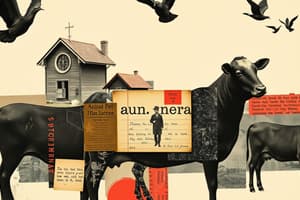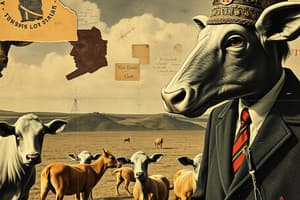Podcast
Questions and Answers
Which animal is often characterized as intelligent and cunning?
Which animal is often characterized as intelligent and cunning?
- Lion
- Fox (correct)
- Bear
- Tortoise
What character trait is typically associated with tortoises in stories?
What character trait is typically associated with tortoises in stories?
- Bravery
- Strength
- Wisdom (correct)
- Agility
How can repeated exposure to animal stereotypes influence societal views?
How can repeated exposure to animal stereotypes influence societal views?
- By encouraging individual emotional connections.
- By eliminating old stereotypes entirely.
- By reinforcing biases and assumptions about animals. (correct)
- By promoting diverse character representations.
What is a common moral lesson conveyed through animal stories?
What is a common moral lesson conveyed through animal stories?
What is a key purpose of anthropomorphizing animals in narratives?
What is a key purpose of anthropomorphizing animals in narratives?
Flashcards are hidden until you start studying
Study Notes
Character Traits
-
Common Traits: Animals in stories often embody stereotypical traits that reflect human characteristics.
- Lions: Courageous, noble, and authoritative.
- Foxes: Cunning, sly, and clever.
- Bears: Strong, protective, and sometimes clumsy.
- Tortoises: Wise, slow, and steady.
- Rabbits: Timid, quick, and agile.
-
Role in Narrative: These traits often serve to quickly establish character roles and dynamics within a story, allowing for immediate understanding of their motivations and behaviors.
-
Cultural Variations: Animal stereotypes may differ across cultures, reflecting local values, beliefs, and folklore.
Impact On Perception
-
Influence on Attitudes: Stereotypes can shape how individuals view both animals and people, reinforcing biases and assumptions.
-
Moral Lessons: Animal stories frequently convey moral messages, with certain traits being celebrated or criticized, such as the cleverness of a fox or the bravery of a lion.
-
Empathy and Connection: Anthropomorphizing animals allows readers to connect emotionally, fostering empathy towards particular traits and behaviors.
-
Reinforcement of Stereotypes: Repeated exposure to animal stereotypes can solidify perceptions, influencing societal views on real animals and their behaviors.
-
Challenge of Stereotypes: Some modern stories seek to subvert traditional animal stereotypes, presenting characters that defy expectations and promote a more nuanced understanding of personality and behavior.
Character Traits
- Animals in narratives often reflect human characteristics through common stereotypes.
- Lions symbolize courage, nobility, and authority, often portraying leadership roles in stories.
- Foxes are depicted as cunning, sly, and clever, representing intelligence and trickery.
- Bears are characterized by strength, protectiveness, and occasional clumsiness, often embodying the protector role.
- Tortoises are seen as wise, slow, and steady, teaching the value of patience and perseverance.
- Rabbits are portrayed as timid, quick, and agile, often emphasizing vulnerability and speed.
- These traits establish character roles and dynamics quickly, aiding audience understanding of motivations and behaviors.
- Cultural variations exist, with animal stereotypes reflecting local values, beliefs, and folklore, differing between regions.
Impact On Perception
- Stereotypes influence attitudes towards both animals and people, often reinforcing existing biases and assumptions.
- Moral lessons are common in animal stories, highlighting traits for celebration or criticism (e.g., fox's cleverness or lion's bravery).
- Anthropomorphism fosters emotional connections, allowing readers to empathize with specific traits and behaviors of animals.
- Continuous exposure to stereotypes can cement societal views on real animals, affecting perceptions of their behaviors and characteristics.
- Some contemporary narratives aim to challenge and subvert traditional animal stereotypes, offering characters that defy expectations and encouraging more nuanced understandings of personality and behavior.
Studying That Suits You
Use AI to generate personalized quizzes and flashcards to suit your learning preferences.




